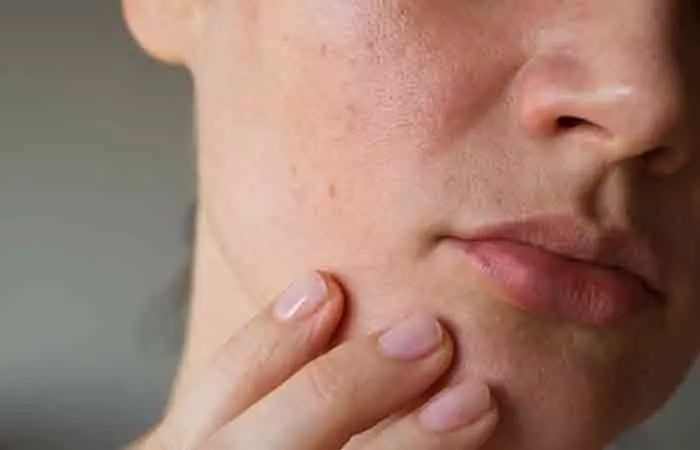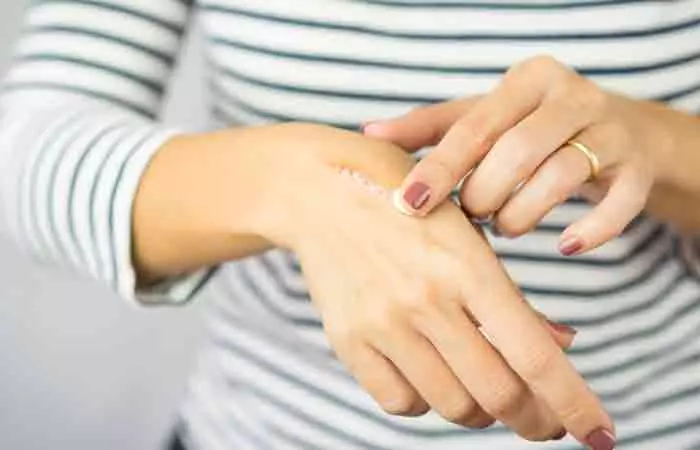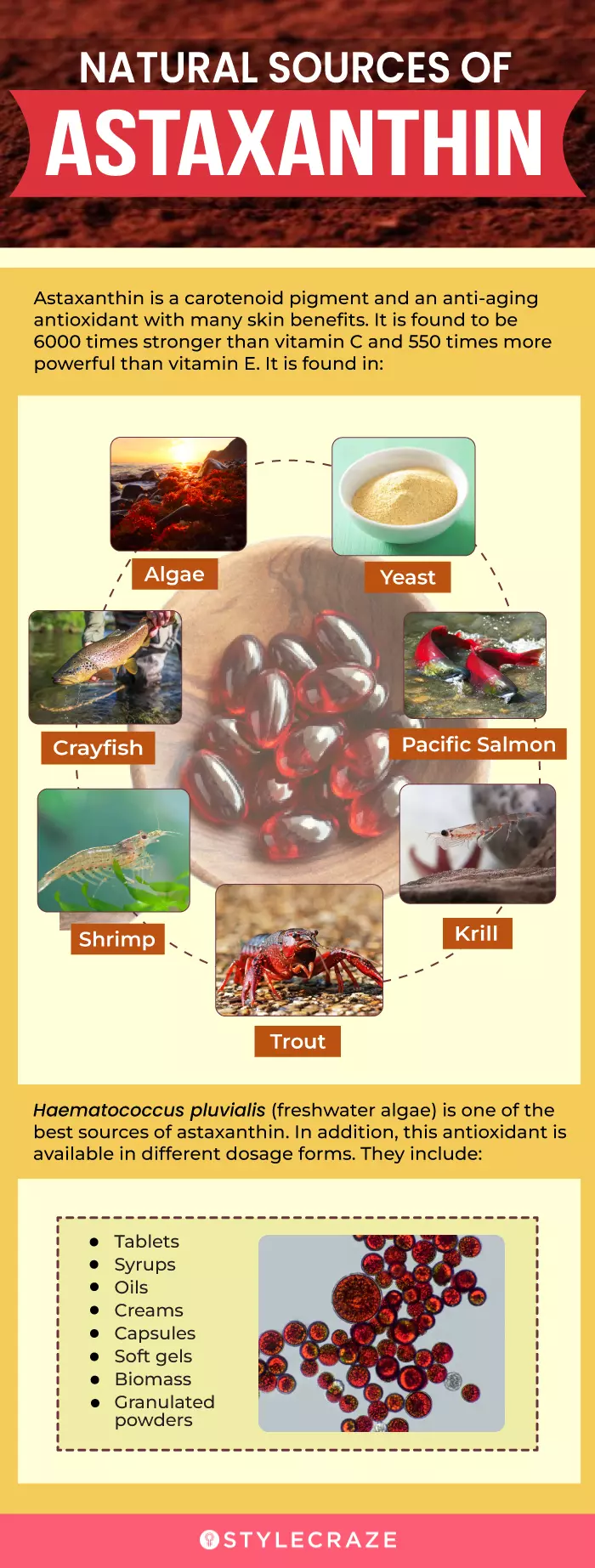Are you curious to learn more about it? This article will take you through what astaxanthin is, how astaxanthin benefits the skin, preventative measures, astaxanthin’s uses in skin care, and side effects. Keep reading to learn all about this unique ingredient!
What Is Astaxanthin?
Astaxanthin is a pigment molecule that is a member of the carotenoid family found in certain marine/freshwater algae. In simpler words, it is the yellow, orange, and red pigments that are produced by plants, algae, and bacteria. Who Can Use It? It can be used by people of all ages (above 18) and skin types, specifically those with sensitive skin. How Often? It can be used twice a day in the form of a serum, oil, or moisturizer. It can also be consumed orally in the form of supplements. Caution Avoid consumption if you are on any other medications, experience any abdominal pain, or develop any allergic reactions.
One of the reasons why it has gained traction is because it is a potent antioxidant. In other words, it is helpful for addressing all kinds of skin issues – reducing skin wrinkles and age spots, enhancing skin elasticity and texture, and increasing the moisture content of the skin (3).
Top 5 Benefits Of Astaxanthin For Skin
Astaxanthin has some great benefits for skin that are backed by scientific research. Research suggests that it has photoprotective, antioxidant, and anti-inflammatory properties (4). In a nutshell, if you have extremely dry and damaged skin, astaxanthin may just be the ingredient you need to add to your daily skin care routine. Here is a quick run-through of its skin care benefits:
1. Protects The Skin Against Free Radicals And Sun Damage
Consuming astaxanthin as a natural supplement can provide UV protection by suppressing the cell damage that is caused by free radicals (5). In fact, this ingredient can even slow down the growth of skin cancer cells and help maintain healthy skin.
2. Reduces Dryness
According to a study conducted in Japan, astaxanthin aids in reducing the loss of skin moisture and improves the texture of rough skin (5).
3. Treats Inflammatory Skin Diseases
Considering that astaxanthin prevents the damaging effects of UV rays on the skin, this ingredient is an important component of several anti-inflammatory drugs that help treat inflammatory skin diseases such as psoriasis and atopic dermatitis (AD) (4).
4. May Prevent Wounds From Becoming Worse
According to research done on rats, astaxanthin has significant antioxidant properties that help activate the cellular antioxidant defense system. This helps in protecting the skin against early burn wound progression and accelerates wound healing (4).
5. Delays Skin Aging
Research also indicates that ASX may have anti-aging properties and play a promising functional role in treating andpreventing skin aging and promoting overall skin health (4). Using a topical cream containing ASX combined with other active ingredients may promote collagen production and significantly reduce wrinkles and puffiness under the eyes and on the cheeks after two weeks of use (4).
6. Improves Skin Moisture And Elasticity
A study was conducted in Italy on women who were given 2 mg of ASX. After six weeks of ASX treatment, significant improvements were observed in their skin moisture levels and elasticity (4). Now that you have a good understanding of astaxanthin’s skin benefits, let’s understand how to use it in the right dosage and with the right precautions to keep in mind.
How To Use Astaxanthin The Right Way
Astaxanthin can be used by people of all ages and skin types. It is particularly useful for people with sensitive skin, owing to its anti-inflammatory properties, which aid in reducing skin redness, sensitivity, and inflammation. If you have dry and damaged skin, using astaxanthin the right way can make a big difference. This ingredient can be used twice every day – morning and night – in the form of a serum, moisturizer, or oil. Make sure to read the label and conduct a patch test to ensure that you are not allergic to ASX. Astaxanthin pills can also be taken orally. You can take astaxanthin in doses of 4 to 40 mg daily for up to 12 weeks or 12 mg daily for 6 months. You can combine it with other carotenoids, vitamins, and minerals at 4 mg daily for up to 12 months. To figure out the ideal dosage for your skin – when using either topically or orally – consult a dermatologist. Finally, let us talk about the side effects of astaxanthin.
Side Effects Of Astaxanthin
Astaxanthin is safe to use when used topically. However, if you are ingesting it, this ingredient can have side effects. Here are a few precautionary measures to keep in mind when consuming astaxanthin in any form (6):
Speak to your dermatologist to figure out if you are allergic to astaxanthin or related carotenoids. Do a patch test before you start using ASX topically. If you have a bleeding disorder, consult a physician before consuming ASX. It may lower your blood sugar levels and blood pressure so keep monitoring both routinely. If you have a hormonal disorder or are on any kind of liver medication, consult your doctor prior to ingesting it. If you are on immunosuppressants or have an auto-immune condition, consult your doctor before taking ASX. ASX may lower your serum calcium levels if you are suffering from hypocalcemiai A medical condition with symptoms like memory loss and muscle spasms that occurs when there is a very low calcium level in the blood. , osteoporosis, or a parathyroid disorderi A medical disorder that leads to abnormal calcium levels in the blood and symptoms like kidney stones, weakness, and brittle bones. . It can cause severe abdominal pain and aplastic anemiai A rare medical condition that occurs when bone marrow damage stops the body from producing sufficient new blood cells. . If you are pregnant or lactating, avoid this ingredient. This ingredient is not safe to be consumed by children (below 18 years of age).
Does astaxanthin darken skin? No, astaxanthin does not darken the skin. It helps improve the skin and protects it from sun damage. Will astaxanthin turn you pink? No, the right amount of astaxanthin does not turn your skin pink. Therefore, always consult a doctor for the right dosage before using it. Is astaxanthin better than vitamin C for skin care? According to anecdotal evidence, astaxanthin might be a better option for some as it is stronger than vitamin C. Using both, astaxanthin and vitamin C for skincare can have antioxidant benefits that manage free radical damage. Which is better, astaxanthin or glutathione? Astaxanthin and glutathione are antioxidants that help protect the skin from damage and promote its health. There is a lack of studies comparing their benefits and hence it is difficult to say which one works better. Does astaxanthin reduce melanin? A study noted that astaxanthin may inhibit the production of melanin and thus may be used to reduce hyperpigmentation and dark spots (3). However, more research is needed to achieve conclusive results. Can astaxanthin be used to treat specific skin conditions, such as acne or eczema? A study showed that astaxanthin may be used to manage the symptoms of atopic dermatitis and itching in mice by regulating the levels of inflammation (8). However, more human research is needed to attain conclusive evidence. Learn about the amazing benefits of astaxanthin. Click on the video below to discover what it is, its sources, and how it can help improve your health.











